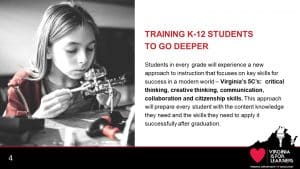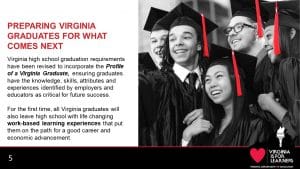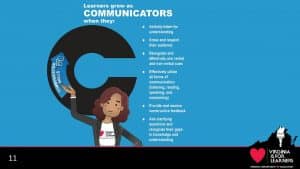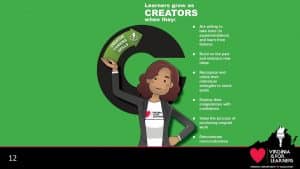Transforming Virginia K-12 Education for Deeper Learning and Future Readiness
Education Domain Blog
The following is an excerpt and transcript of the Aurora Institute 2019 Symposium TED-style keynote address, delivered on October 29th by Virginia State Superintendent of Public Instruction Dr. James Lane. One of three TED-style talks from school leaders who were transforming learning, Dr. Lane shared how his state shifted culture and built capacity for equitable deeper learning. He also shared the tenets of the Virginia Is for Learners initiative, the work of the state’s innovation networks, and steps other states can take to achieve similar results.
That’s from a student named Justin on the western side of Virginia. When we started our work to promote deeper learning in the state, we asked school divisions to send us examples of what they’re working on, and Justin and his teacher Cole sent me that video. So I appreciate you giving me a few extra seconds there because I promised them I was going to play that as my walk-up music every time I came on the stage. And at the end, I’ll play more of it for you.
His song starts with, “Worksheet worksheet, not another worksheet.” Then he goes on to say, “Why don’t you teach us how we learn best?” Right? And that is what is at the heart of Virginia Is for Learners. Now, you’ve probably heard at some point of our Tourism Corporation slogan, “Virginia Is for Lovers,” and that was intended to encourage folks to come visit our beautiful beaches and mountains and the history of Virginia. But, Virginia Is for Learners is the Commonwealth’s commitment to public education and a belief that our job is to tell the story of the great things going on in our public schools so that those people who come to visit Virginia will stay and bring their businesses with them because we are, based on CNBC, the number one state for business. Inside the rankings for the number one state for business, CNBC rated Virginia as number one and two subcategories: education and the workforce. And so, Virginia Is for Learners is about making sure that we stay number one, but it’s also about a commitment to making sure we’re lifting up the students that need us the most because that is how we’re going to continue to move forward as a state.
Now, when we started the major education reforms that we have done in Virginia over the last couple years—actually started before I arrived in 2018 with the adoption of new standards of accreditation, new way of holding our schools accountable, that looks at more measures. When we started that work, we realized our superintendents, our principals, our teachers knew what we were trying to do. But our parents, our business leaders, had no idea.
 So we created Virginia Is for Learners originally as a campaign to talk about all the amazing things going on in our schools. And so Virginia Is for Learners is built on three pillars. The first, is training our K-12 students to go deeper. That is really what we’re talking about here today. We created a Profile of Virginia Graduate; you can find that online. We focused on five critical skills. I’m going to talk about these more in more detail in a moment, but critical thinking, creative thinking, communication, collaboration, and citizenship. I often say that the hardest part about being state superintendent is remembering those five things in front of a group. But what I will tell you is that when I began speaking to business leaders when I became a superintendent 10 years ago, all of their comments focused on the basic skills that students needed. We need kids that can read better, do basic math. And that’s changed over the 10 years. And now business leaders say to me, “You know what? Virginia kids are book smart.” And I often say I will take that. “But what we really need is for them to have these critical skills when they come in, and if they have these skills, we can teach students to do the work that we’re doing.”
So we created Virginia Is for Learners originally as a campaign to talk about all the amazing things going on in our schools. And so Virginia Is for Learners is built on three pillars. The first, is training our K-12 students to go deeper. That is really what we’re talking about here today. We created a Profile of Virginia Graduate; you can find that online. We focused on five critical skills. I’m going to talk about these more in more detail in a moment, but critical thinking, creative thinking, communication, collaboration, and citizenship. I often say that the hardest part about being state superintendent is remembering those five things in front of a group. But what I will tell you is that when I began speaking to business leaders when I became a superintendent 10 years ago, all of their comments focused on the basic skills that students needed. We need kids that can read better, do basic math. And that’s changed over the 10 years. And now business leaders say to me, “You know what? Virginia kids are book smart.” And I often say I will take that. “But what we really need is for them to have these critical skills when they come in, and if they have these skills, we can teach students to do the work that we’re doing.”

Next is preparing our Virginia Graduates for what comes next. I will tell you that when I was a kid, like most people of my generation, I had a job in high school. And what we find now is that many kids don’t have a job in high school like many of us had. They’re busy. We have so much more homework now. We have so many more clubs and activities for students. There’s so much for them to do. But when I go to see the places that kids typically worked when I was a kid, I see adults working in those roles. And so, we’ve got a responsibility to make sure we create work-based experience for students so they can experience the real world in the classroom, so that when they go to the world of work, they know how to implement those skills that we’re always talking about. We’ve got to move beyond content to those skills and create those work-based learning experiences.

Now, the third piece of what we did in Virginia Is for Learners is we made student success the highest standard. We fundamentally changed the way that we hold schools accountable. We added a focus on growth, and not just achievement, because as a parent of a student who’s likely going to pass our standards of learning test every year, I don’t care if he’s going to pass that test. I want to know where he was at the beginning of the year, and whether they maximized what he could do toward the end of the year. And at a minimum, I want to know that he grew a year while he was with our teachers. We also have always measured achievement gaps. We reported them based on the federal government requirements, but we never actually in our state accountability system held our schools accountable for closing achievement gaps. So the new system now focuses on racial equity for our students. We wanted to make sure that we recognize continuous improvement for our schools and didn’t label our schools as failures because we wanted to know that every school had something to work on.
When we wanted to share this information with parents and we wanted to get to every parent in every corner of Virginia, we created a video series. I’m going to show you one very short 45-60 second one. And we created a character, Mary Peake. Mary Peake was one of the first African American educators in Virginia. She started a school on what is now Hampton University. And Mary Peake is going to tell you a little bit about our work.
Now, the reason that we created these videos is because, imagine the power of the work that we’re doing, all of us trying to build these deeper learning experiences, these competency-based experiences, these personalized mastery learning experiences for students. Imagine if our parents could communicate as clearly as we can on why we’re doing it. And so you see, we have our 5Cs graphic—feel free to borrow that if you’d like. But we also went through each of the five skills areas and clearly defined what that looks like in the classroom.
 So for critical thinkers, as you’ll see—I’m not going to read them all to you—but we want our students to be able to reason and make inferences. We want them to be able to reflect on their own thinking.
So for critical thinkers, as you’ll see—I’m not going to read them all to you—but we want our students to be able to reason and make inferences. We want them to be able to reflect on their own thinking.

As collaborators, certainly we want them to be able to work together. But we want them to value each other, the diversity and the opinions of every student in the classroom.

As communicators, we want to make sure they’re learning to actively listen because they can talk plenty in class for those y’all who are teachers. You know I’m kidding.

We want them to be creators. At the end of the day, the future economy in our world is going to be with the entrepreneurs, and we want our students to have those experiences every day in school. We don’t have to just talk about what these skills are. We have to build them into our standards and our assessments, so students have opportunities to experience this learning. Everyone typically has at least those first four Cs. In Virginia, we added community-minded citizens. But we also focus on global citizenship. We also focus on work citizenship, so students don’t just think as citizenship as character and being ready for school every day, but the type of activities that they’ll need to do when they get into the workplace.
So why are we doing this work? Why are we focused on more deeper-learning focused education in Virginia? Well, really, it’s all about equity. And you can probably tell what generation I’m from, you know, because Jay Z’s music was huge when I was in school, but he talks about how everyone is born with genius-level talent. Think about if we thought about all of our children that way every day. That all of our children had some genius-level talent and our job was to cultivate it. How much we would think about personalizing experience for that student so that they could grow those talents!
What if we thought about how if everything that we did was about maximizing their potential, and not about whether they could pass the test? But actually, it’s about seeing how far they could go with their learning. Now people ask me, “Well, what are you doing for equity?” And I say, “Well, I can tell you some of the things we’re doing, but equity is not necessarily a strategy.” It’s a lens that we put on everything we do, from our hiring, to our policies, to our finances, to our resources to make sure that we’re lifting every child up. Because—and I don’t know what your state looks like, but I guarantee if you created a map of your state, it would look like this.

And just for quickly analyzing it blue is good and red is bad.
So for all of our students, we’re doing pretty well as a state. Our Asian students are doing well. Our Caucasian students are doing well. But we have some significant achievement gaps. And you don’t see that until you really look inside it. And then you look at where and you look at a county by county. But the most shocking pieces for our students with disabilities, or English language learners, if we don’t include growth, none of our school communities are having the impact with those students that we want. So that’s why we have to focus on deeper learning because the way that we’ve taught them with rote memorization doesn’t work for all students. We have to make sure we’re really engaging them, really getting them excited about learning if we’re actually going to maximize their potential and have them ready for state assessments.
So how are we going to build this culture in Virginia? Well, first, leadership matters. You have to set a vision no matter where you are. Whether you’re a teacher in the classroom, a parent or an advocate in this room, or the superintendent of your state, you have to set a vision that every child matters and that we’re going to create learning experiences that makes them excited to come to school every day. If you work at the state level, like I do, we focused on becoming what we call the Tower of Yes. If you’ve ever dealt with your state department, we have a tower—that’s actually our building—and we’re on the top floor of that huge building, tallest building in Virginia. We were referred to as the Tower of No because every time somebody wanted to innovate, and they asked us at the state level, we had a reason or a policy that was preventing it. But when I got there, and the superintendent before me, I can tell you, we looked at those regulations. There’s plenty of flexibility to do what we wanted to do. So we turned that Tower of No into a Tower of Yes because we want to drive innovation in our state.
One of the ways that we do that was grants, pilots, and flexibility. I saw some teachers here that came up to me yesterday that said, they’re from Code RVA—shout out to Code RVA. We gave $50,000 grants for high school innovation. Fifty-thousand dollars will barely buy anything to innovate your school, but it was the permission to move forward and ask for flexibility and waivers. Code RVA is a new school in Virginia. It’s based on three pillars. It’s equitable, because the students in that school are a mere reflection of the nearly 15 school divisions that partner to regionalize that school. It’s built with a focus obviously on computer science so that students have a real skill when they graduate. It was built on a focus on personalized learning so that every student had a personalized pathway through school, and every student in that school has the opportunity to graduate with a two-year degree. And in their last couple years of high school, they work in a paid internship, so that when they graduate, they get promoted along the way, when they graduate. They have one or two years of work experience, and they can either go right into work or on to a degree.
But the key, as Kirsten said, is family engagement. We have to have our parents longing for and begging for these richer and more engaging experiences if they’re going to be institutionalized. You have to reach your parents and share with them why this work is so important because when the parents are clamoring for it, it will become a part of everything that we do. We can put it in our standards. We can change our assessments. But if you want it to be there for the long haul, it has to be understood by every member of your community.
And leverage the technology that’s open to you, because remember, the technology is a tool, not a goal. So many times, I see districts celebrating their new technology enhancements and calling it innovation. But innovation is both new and better. So many times, we think of innovation is the new thing. The other thing that I will say is don’t be afraid of technology either, because when the pencil became the new tool for the chalkboard teacher or however slate or whatever they were doing, I can tell you that the pencil didn’t change the classroom, but the pencil was the tool that allowed teachers to do something different. Think of the technology available to you in the same way. And then lastly, you have to build capacity. If you’re a district that’s just taking on this deeper learning focus, it will not change overnight. It’s a new paradigm, and you need to think about it differently. And like Kirsten talked about assessments, we often have to think differently about the way we evaluate folks because we can’t ask our teachers to do this more innovative type of learning and still hold them mostly accountable for test scores based on old rules.
We’ve got to make sure that we build innovation networks. We’re partnering with advanced learning partners and Ted Dintersmith and others, and we built an innovation network of 26 school districts that are taking this work on first and building it to capacity. In that first year, when we brought those first 26 school divisions in, 52 applied, and now we’re going to be well over 70 interested. We’re creating what Ted loves to call innovation playlists because you don’t have to do the same thing as your neighbor next door, but you do have to think about how you can make your classrooms better. There are many ways to go about that.
But really in closing, the big challenge I want to leave with you is to make sure you tell your own story. I work very closely with the media all the time. The media is more likely to run a story about a fight or late bus than all this amazing work that we’re doing. But if I have 1.3 million students, then theoretically I have 2.6 million parents or guardians, which means that there are nearly 4 million people that I get to communicate with every day, which is a more powerful audience than anywhere in the media. But imagine if every educator in this nation, if every educator in your state, or even every educator in your school was telling your story, how much more powerful the work that we were doing would be. Thank you very much. I’m gonna leave you with Justin.
Dr. James Lane is Virginia’s State Superintendent of Public Instruction. Continue to watch this space for more from the 2019 Aurora Institute Symposium TED-style keynote addresses. See more highlights from the entire conference on this webpage.